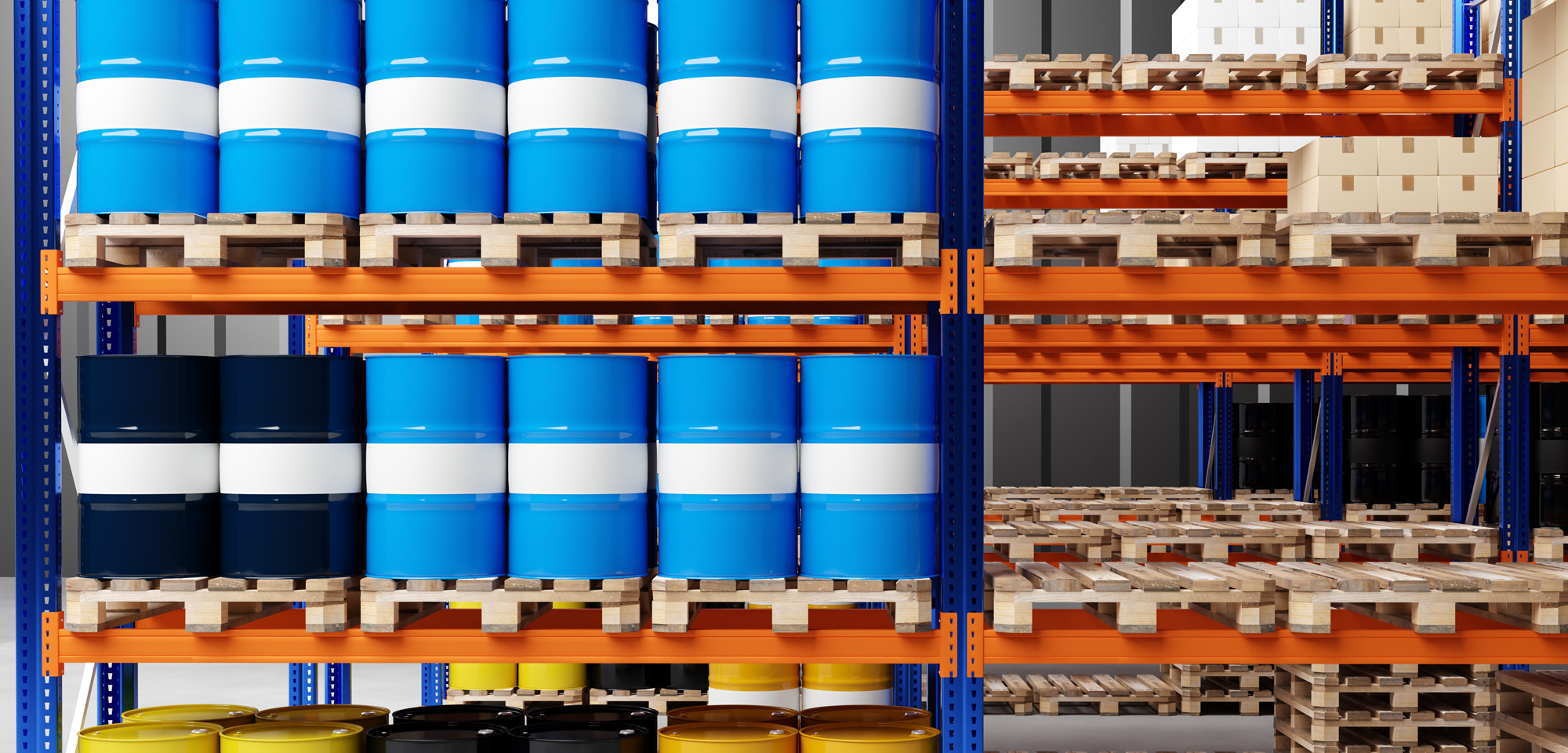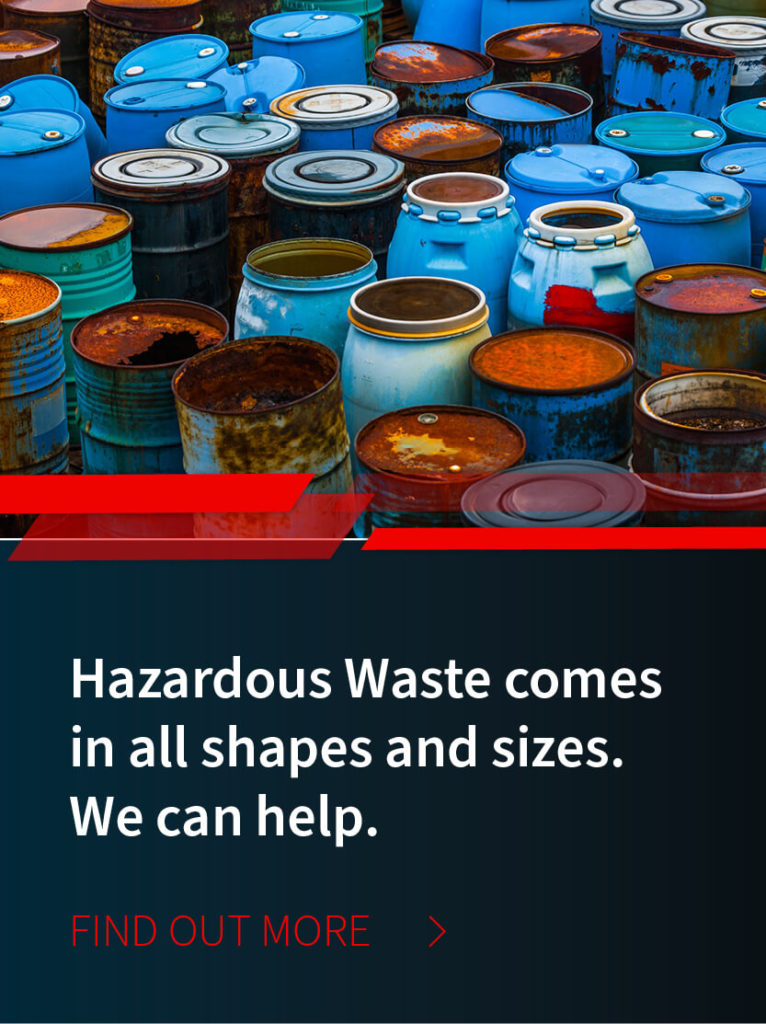
/ IN THIS BLOG
Hazardous waste removal processes involve numerous steps. One of the most crucial is how to select a proper and compliant hazardous waste container. This is not a one-size-fits-all process, as the right container for the job depends on factors that include the type of waste, its weight or volume, and its components.
01 / Hazardous Waste Containers: What to Know about Selecting Them
Hazardous waste is defined as any component that is or even might be corrosive, toxic, corrosive, or flammable and therefore requires proper and safe containment during storage or transportation.
All hazardous waste containers, bins, boxes or barrels must be compliant with state and federal laws and regulations. Specific guidelines can be found on the website of the Environmental Protection Agency here, or under the Federal Code of Regulations Title 40 Parts 260 through 273. For example:
Part 262: Standards Applicable to Generators of Hazardous Waste.
Part 263: Standards Applicable to Transporters of Hazardous Waste
Other regulations provide guidance on identification of hazardous waste and compliant processes for preparing and labeling such waste for transportation off-site for disposal.
Other than the EPA and the regulations of the Resource and Conservation and Recovery Act (RCRA), the guidelines of the Department of Transportation (DOT) must also be followed for compliance. In addition, every state also has their own transportation departments, in addition to Natural Resources Departments, which not only follow the federal guidelines, but often institute additional rules that are even more stringent than those of the federal government.
02 / About DOT-Approved Hazardous Waste Containers
When it comes to hazardous waste containers, don’t guess. Even if you think a container is sturdy and effective, it won’t be compliant if it is not specifically approved and certified by the Department of Transportation (DOT) for that particular waste type. In such cases, you can be fined by the EPA for non-compliance. To be fully in federal compliance with all regulations, you need to store and transport all waste in DOT- approved containers. Every time.
Be familiar with the DOT’s Hazardous Materials Regulations, which includes not only transportation laws, but also the regulatory authorities involved in such transportation and their enforcement procedures. You can also review the DOT’s 2021 publication of the Federal Hazmat Law for hazardous materials transportation here.
Some people who don't follow this rule do so to save money; others legitimately don't know they need DOT- approved containers, or they think what they're using counts. Your motivation, however, is irrelevant. If you're not in compliance, you're liable to pay the EPA fines.
An approved DOT container meets specific standards for safety when transporting hazardous materials. The agency classifies hazardous materials into nine categories ranging from explosive (Class 1) to Flammable (Class 4) to Miscellaneous and Dangerous Materials (Class 9). So whether your hazardous waste is in liquid, gaseous, or solid form, always use the right container for the type of waste generated.
03 / Choosing an Appropriately Sized Container for your Generated Waste
A variety of container sizes are available for transportation of hazardous waste based on thickness of a drum, materials used, and closing or latching mechanisms. A few options include but are not limited to:
5, 10, 20, 30, 55 gallon drums
Multi-sized barrels
Cubic yard boxes (ideal for those generators who fill up drums too quickly)
Bags or totes with plastic inner linings and exterior metal cages to avoid punctures (used primarily for liquid waste)
Tote tanks (stainless steel)
Approved hazardous waste containers are constructed of different materials for different type of hazardous waste, such as steel, aluminum, fiberboard, plastic, and so forth, but they must be coded and numbered and lettered per DOT guidelines.
Even more important than the size of the container is what that container is made of. For example, corrosive waste must never go into a metal drum, as it can eat through metal and cause minor to major leaking or even complete container failure. All corrosive waste must be stored and transported in a plastic or plastic-lined container or drum, while steel containers are more suitable for flammable waste.
Review 40 CFR 265.177 for additional information on ‘Special Requirements for incompatible wastes’. Also, Title 40, 262.17 offers detailed instructions for generators of hazardous waste when it comes to hazardous container management and labeling. Be aware that specific rules depend largely on your EPA generator status.
04 / Be Aware of Everything in a Hazardous Waste Container
One of the most potentially dangerous situations can occur when multiple types of waste are combined in one container. If those waste types react or interact negatively, you could be dealing with explosions, fires, toxic fumes, or complete container failure. This is true whether you're mixing a lot of two substances or even residual waste in a reused container that has not been properly cleaned.
Waste types—from corrosive to flammable to reactive waste—need to be conscientiously segregated and stored in the containers that are appropriate for those waste types.
05 / Preparing for Transport - Label Hazardous Waste Properly
Once you're certain you've chosen the correct container and are storing the correct waste type in that container, it's crucial to properly and accurately utilize hazardous waste labels. Every container containing hazardous waste requires a yellow hazardous waste label. This offers an immediate cue to anyone handling that waste that it is a hazardous material.
This label should include but is not limited to:
Generator information – facility name and address
A list of the contents as ‘Hazardous Waste’
Composition and physical state of the waste (liquid, gas)
Any relevant EPA waste code
Accumulation start date of waste
Turn to 40 CFR 262.31 through 262.33 for guidelines of what information to place on labels and where to place them on each and every container transported off-site.
06 / Maintain Status of Waste Containers—Not Just When Transporting
Always want to be conscious of your waste containers. For example, while storing waste, inspect periodically to ensure nothing is leaking. A compromised waste container has the potential to damage your facility or pose serious safety hazards for you and others who come in contact with the waste. If the container is compromised when it goes on the truck for transport, this can likewise pose potentially disastrous health and safety hazards.
All lids should be attached and sealed properly (required amount of torque will vary from container type to container type).
Routinely check for dings, dents, or anything unusual with your containers. It's always better to be safe than sorry in these situations. If you inspect a drum and have doubts about its integrity, always repackage that waste. This improves overall safety and reduces the chance you'll be financially and otherwise held liable if any damage is caused because of your waste (during transport or not).
07 / Contact an Experienced Hazardous Waste Disposal Company for Guidance
Choosing a waste container is more involved than it might seem. If you're unsure about any of these steps, reach out to an experienced and reputable hazardous waste disposal company such as MCF Environmental Services. We ensure compliance when it comes to hazardous waste containers and transportation guidelines.
Remember that even if you work with hazardous waste removal company, you'll still likely be packing and storing that waste, so make sure that the company you work with is willing and able to provide guidance and education about everything required of you.
For more information about what you need to do to ensure your waste containers are in compliance with all state and federal regulations, reach out to a representative of MCF Environmental Services.
Robert Losurdo
President, COO








